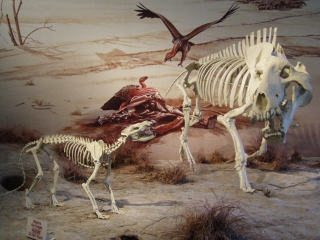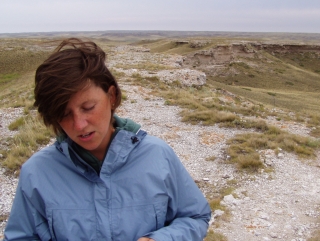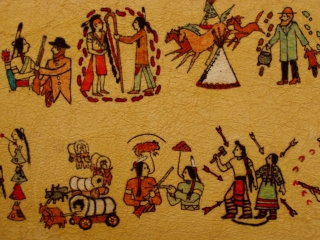NPS Website
 WHAT IS IT?
WHAT IS IT?Area from which fossilized remnants of a Miocene Era (23 million years ago) savannah ecosystem have been unearthed.
BEAUTY (3/10)
Just rolling hills of wavy grass.
HISTORICAL INTEREST (8/10)
20 million years ago, the Nebraska panhandle strongly resembled the Serengeti Plains of Tanzania and Kenya. Just as it does in the standard African savannah National Geographic Film, the Nebraska Plains went through periods of extreme drought followed by rejuvenating rains. Animals, both then and now, congregate at water holes. At Agate, the long drought exhausted both the food and water supply and many animals perished. Those who died at the water hole were buried, many intact, once the rains came and silt, sand and sediment rushed into the sunken areas. This process happened generation after generation, burying layers upon layers of fossilized skeletons. We have been able to reconstruct the savannah animals of this time via the remains at Agate.
The Site also includes the incredible James H. Cook Collection of Indian Artifacts. Cook was the rancher who owned the land and discovered the Fossil Beds. He was also a close friend of Lakota Sioux Chief Red Cloud. Red Cloud gave an impressive array of artifacts to his friend, including his intricately beaded moccasins, the war club that killed Col. Fetterman at the Battle of the One-Hundred Slain and the peace pipe smoked during the signing of the Fort Laramie Treaty of 1868.
CROWDS (6/10)
Surprisingly, there were a few others at the remote site at 8:00am on a Thursday. They did not affect our visit in any way.
EASE OF USE/ACCESS (1/5)
Agate Fossil Beds NM is located in the rural panhandle of Nebraska, nearly 100 miles from any Interstate. Harrison, Nebraska, population 279, is located 25 miles to the north. Harrison is home to the Sioux Sundries soda fountain, purveyors of the world-famous “Coffeeburger”, two full pounds of Black Angus madness.
CONCESSIONS/BOOKSTORE (3/5)
The dimly lit bookstore nook did not have hundreds of titles, but it did have a nice selection, particularly children’s books. Small posters of a Sioux Winter Chart and a very cool “Correlated History of Earth” were available for sale. If the A*tima weren’t so stuffed, we would have been tempted to purchase both.
 COSTS (3/5)
COSTS (3/5)Admission is $3 per person, $5 per vehicle. Children, defined here as 16 and under, are free. There is no entry fee if you have the National Parks Pass.
RANGER/GUIDE TO TOURIST RATIO (2/5)
We arrived at the Site at 8:15am, just after it opened. This was the wrong move. The Visitor Center and the Museum were nearly abandoned, staffed by a Ranger who seemed to disappear when we wanted to ask questions. We saw two more Rangers arriving around 9:30, just as we left to go on the self-guided Daemonelix Trail. Later that day, at the Badlands NP Stronghold Unit we saw a picture of one of those two Rangers. The Badlands Ranger told us that the person in the photo is in charge at Agate and is a renowned sedimentologist. It seems the early bird does not always get the worm.
TOURS/CLASSES (5/10)
Both sections, the Indian artifacts and the Paleontology exhibits, of the museum were very well done but different in their objective. The Cook Collection’s primary focus is to display the Sioux items.
The Paleontology exhibits describe the archeological process and methodology, show the history of Agate and explain the unique biosphere of a 20 million year old savannah. This is done through numerous hands-on displays, film and full-size reassembled skeletons.
The Site provides self-guided trail pamphlets to both the Daemonelix Trail and the hike to University Hill and Carnegie Hill (the Site of the major excavations). There were once enclosed fossil exhibits at the base of the Hills. Soon after their construction, they were broken into and the fossils stolen.
The two scheduled guided Ranger tours were cancelled the day of our visit because of staff cuts.
FUN (7/10)
We didn’t get a guided Ranger tour and we just missed meeting a world-renowned rock guy, but we managed to entertain ourselves pretty well. We had all the time we wanted to enjoy Red Cloud’s gifts to his friend James Cook. We appreciate the Cook family’s gift to the Park Service.
Fossils and bones aren’t normally exciting – at least not to Gab. But the interactive displays and explanations in the Visitor Center livened up the topic. The sheer volume of fossils at Agate is amazing. Looking at the reproduction of the fossil bed and reconstruction of some of the larger mammals made us feel young again. Like kids pointing at the big dinosaur at the local museum.
The morning air was crisp. We enjoyed our self-guided walk on the Daemonelix Trail. Plus, the trailhead was on the way out of the monument – that much closer to our burgerlicious lunch in Harrison.
 WOULD WE RECOMMEND? (7/10)
WOULD WE RECOMMEND? (7/10)We could have made the trip to Agate Fossil Beds NM when we traveled to Scottsbluff NM and Chimney Rock last month. If you find yourself in the Nebraska panhandle, one could make a nice day trip to these three destinations. We didn’t stop at Carhenge. But that’s just down the road.
TOTAL 45/80
www.usa-c2c.com
© 2004-06